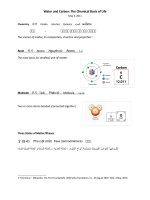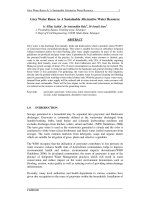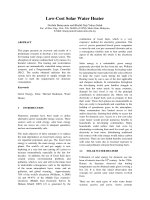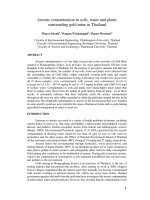W10 water, vitamins minerals
Bạn đang xem bản rút gọn của tài liệu. Xem và tải ngay bản đầy đủ của tài liệu tại đây (948.99 KB, 37 trang )
Water, Vitamins & Minerals
Vitamins
Certain vitamins and minerals are needed
for the body to function.
◦ 13 vitamins
◦ 22 minerals
Two types of vitamins
◦ Water-soluble
◦ Fat-soluble
Fat-Soluble vitamins
Vitamin A, D, E and K
Excess is stored in the liver and in body
fat
◦ It is possible to build up to a toxic level
Vitamin A (Retinol)
Beta-carotene is converted into vitamin A
Vitamin A:
◦ Promotes good vision
◦ Promotes healthy skin
◦ Helps with growth and maintenance of bones,
teeth, and cell structure
RDA: 900 micrograms for males; 700
micrograms for females
Too much vitamin A
May turn your skin orange
May cause fatigue, weakness, severe
headache, blurred vision, hair loss and
joint pain.
Toxicity:
◦ May cause severe liver or brain damage
◦ Birth defects
Too little vitamin A
May cause night blindness
Lowered immune system
Foods rich in vitamin A
Foods
◦ Only animal products
Liver
Eggs
Milk, butter and cheese
Carotenoids
◦ Orange/Yellow fruits
and vegetables
Cantaloupes, carrots,
sweet potatoes, winter
squash
◦ Leafy green vegetables
Spinach, broccoli
Vitamin D – “The Sunshine Vitamin”
Essential for building and maintaining
bones and teeth
Responsible for absorption and utilization
of calcium
Other health benefits:
◦ May boost immune system
◦ May also help decrease certain cancers
RDA: 5 micrograms until age 50
10 micrograms / day until 70; 15 mcg 70+
Too little vitamin D
Vitamin D deficiency has been in the news
a lot lately.
Deficiency may occur from:
◦ Inadequate diet
Vegetarianism, lactose intolerance, milk allergy
◦ Body unable to absorb needed vitamin D
◦ Limited exposure to sunlight
Vitamin D Deficiency
May lead to osteomalacia and/or
osteoporosis
Getting vitamin D
Sun exposure for 10 minutes a day
Foods:
◦
◦
◦
◦
Fortified milk
Tuna
Salmon
May need a supplement
Check with doctor first though
Vitamin E
Important to red blood cells, muscles and
other tissues
Deficiency is rare
Toxicity is rare
◦ But Vitamin E acts as a blood thinner
Foods:
◦ Vegetable oils, salad dressings, whole grain
cereals, green leafy vegetables, nuts, seeds,
peanut butter and wheat germ.
Vitamin K
Important for blood clotting
◦ Also has a role for bone health
Mostly made in the intestines
Foods:
◦ Turnip greens, cauliflower, spinach, liver,
broccoli, kale and cabbage
Water-Soluble Vitamins
Vitamins Bs and C
Eight B vitamins:
◦
◦
◦
◦
◦
◦
◦
◦
Thiamin (B-1)
Riboflavin (B-2)
Niacin (B-3)
Pyridoxine (B-4)
Cobalamin (B-12)
Folic acid
Pantothenic acid
Biotin
Thiamin or B-1
Helps to convert carbohydrates to energy
Deficiency:
◦ Fatigue, nausea, depression, nerve damage
Foods:
◦ Pork, beef, liver, peas, seeds, legumes, wholegrain products, and oatmeal
Riboflavin or B-2
Key to metabolism and red blood cells
Deficiency:
◦ Dry, scaly skin
Foods:
◦ Milk, yogurt, cheese, whole-grain breads, green
leafy vegetables, meat, and eggs
Niacin or B-3
Also involved with energy production
Also helps with skin, nerves and digestive
system
Deficiency:
◦ Rare but causes: diarrhea, dermatitis, dementia
and death
Foods:
◦ Meat, poultry, liver, eggs, brown rice, baked
potatoes, fish, milk, and whole-grain foods
Pyridoxine or B-6
Involved in chemical reactions of proteins
and amino acids
Deficiency:
◦ Skin changes, dementia, nervous system
disorders and anemia
Foods:
◦ Lean meats, fish, legumes, green leafy
vegetables, raisins, corn, bananas, mangos
Cobalamin or B-12
Helps with nervous system, red blood
cells and DNA synthesis
Deficiency:
◦ Nervous system disorders and pernicious
anemia
Foods:
◦ Only found in animal products
Meat, fish, poultry, eggs, milk products and clams
Folic acid (Folacin, Folate)
Key role in red blood cell formation and
cell division
Deficiency:
◦ Anemia, digestive disorders
Foods:
◦ Leafy, dark green vegetables
◦ Also found in liver, beans, peas, asparagus,
oranges, avocados
Pantothenic Acid and Biotin
Help with metabolism and formation of
some hormones
Deficiencies are rare
Foods:
◦ Almost any food, plant-based or animal-based
Vitamin C
Important to bone health, blood vessel
health, cell structure and absorption of
iron
Deficiency:
◦ Rare
Too much vitamin C
Foods:
◦ Melons, berries, tomatoes, potatoes, broccoli,
fortified juices, kiwi, mangos, yellow peppers
and citrus fruits
Minerals
22 minerals are needed by the body
Two categories:
◦ Major
Include calcium, chloride, magnesium, phosphorus,
potassium, sodium, and sulfur
◦ Trace
Include iron, zinc, iodine, selenium, copper,
manganese, fluoride, chromium, molybdenum,
arsenic, nickel, silicon, boron and cobalt
Sodium
What does sodium do for you?
◦ Helps maintain fluid balance
◦ Helps transmit nerve impulses
◦ Influences contraction and relaxation of
muscles
Sodium & Health
Too much sodium
◦ Causes high blood pressure
◦ May lead to fluid retention









